I have used Amazon affiliate links on this page. As an Amazon Associate, I earn a commission from qualifying purchases at no added cost to you. Thank you!

Table of Contents
Introduction to Red Empress Cichlid

Due to their striking colors and unique body shape, Red Empress Cichlid is a favorite among aquarium enthusiasts. Also known as Spindle Hap/Cichlids (Protomelas taeniolatus), these fish originated from the waters of Lake Malawi in Africa. When you take one look at them, it’s easy to see why they have such a catchy name.
The fish’s name derives from a body coloration reminiscent of empresses in China during the Qing dynasty. In captivity, it can come in a wide range of colors, including yellow, red, and blue. The Red Empress Cichlid is named for its bright red coloring and its resemblance to Chinese empresses.
Note that, the bright hues of this freshwater fish can vary depending on the type of habitat it inhabits and the other members of its shoal.
Red Empress Cichlid Behavior and Social Structure
Red Empress Cichlids are known for their peaceful and docile nature. They are not aggressive towards other species and can coexist peacefully in a community tank. However, it’s important to note that keeping multiple male Red Empress Cichlids together in a small tank may lead to territorial aggression. It is recommended to keep a ratio of one male to three females in order to maintain harmony within the group.
These cichlids are not schooling fish, but they do well when kept with similar species from Lake Malawi. They are generally tolerant of other Malawi cichlids and can be housed with compatible tank mates. It’s crucial to research the temperament and compatibility of potential tank mates before introducing them to the Red Empress Cichlid’s tank.
Red Empress temperament towards tank mates
When selecting tank mates for Red Empress Cichlids, it is important to consider their peaceful nature and specific habitat requirements. Here are some compatible tank mates that can coexist harmoniously with Red Empress Cichlids:
- Other Malawi Cichlids: Red Empress Cichlids get along well with other cichlid species from Lake Malawi, provided they have similar temperaments and water parameter requirements. Examples include Yellow Lab Cichlids, Electric Blue Haplochromis, and Acei Cichlids.
- Synodontis Catfish: These catfish species are known to be compatible with Red Empress Cichlids. They are peaceful bottom-dwellers and can add variety to the tank.
- African Cichlid Companions: Certain species of African cichlids, such as Electric Yellow Cichlids, Rusty Cichlids, and Blue Dolphin Cichlids, can coexist peacefully with Red Empress Cichlids.
- Non-Aggressive Bottom-dwellers: Adding peaceful bottom-dwelling species like Bristlenose Plecos, Corydoras Catfish, or Yoyo Loaches can add diversity to the tank while minimizing competition for territory.
It is crucial to monitor the behavior and compatibility of tank mates and make adjustments as needed to ensure a harmonious and stress-free environment for all the inhabitants.
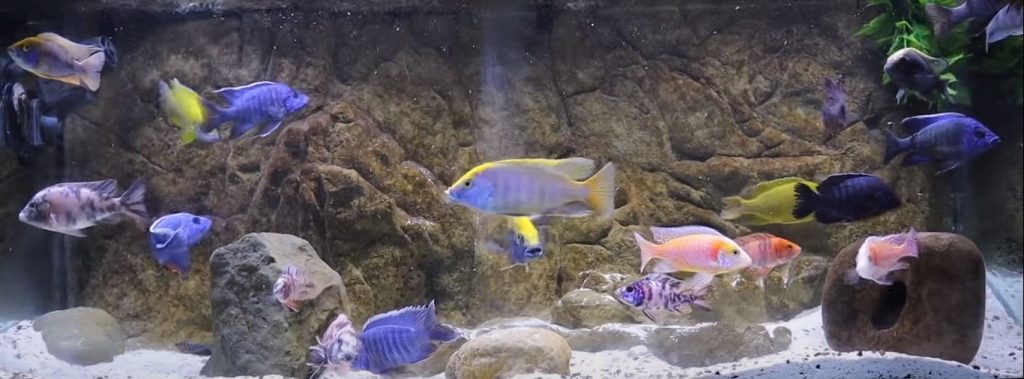
Some of the well-known tank mates of the Red Empress Cichlid are shown below.
- Blood Parrot Cichlids
- Livingstoni Cichlids
- Venustus Cichlids
- Pictus Catfish
- Ropefish
The Lifespan of Red Empress Cichlid
Even under less than ideal conditions, it can live comfortably for five years. With good care, a Red Empress Cichlid may even live up to ten years. This means the hobbyist has to provide a well-balanced diet, and water parameters to enjoy the full lifespan of this amazing aquarium fish.
The appearance of Red Empress Cichlid
Let’s now take a look at the color profile and body characteristics of the Red Empress.
Color

The most common varieties of Red Empress Cichlid have vibrant reds and blues, but other hues can be found in rare breeds with different levels of red and blue. The distinctions between red and blue are hard to see in the younger fish, but growth spurts and more developed muscles make it easier to tell the two apart as they age.
As cichlids get older, they may lose some of their original colors. Over time, they will become darker, shifting from more vibrant reds and blues to a dark reddish-orange hue. In general, however, these fish can retain their striking colors throughout their lives.
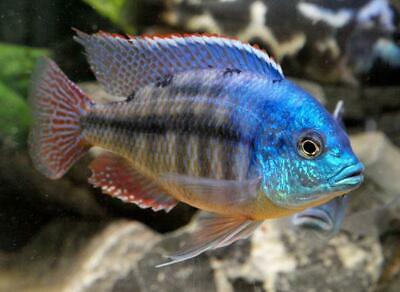
Red Empress Cichlid has faint horizontal lines and oval shapes underneath their color.
Overall If a fish has higher color intensity and clear horizontal stripes, we can say it has better quality and is in good health.
Note that all the color descriptions are valid only for the male fish, which will get into the next subtopic.
Red Empress Male Colors & Captive bred varieties
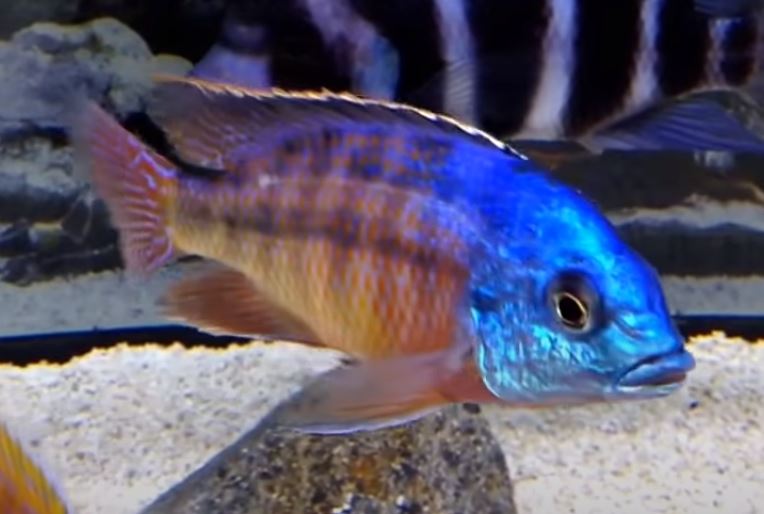
The males are brighter and more colorful than their diminutive counterparts who are basically gray and dull in appearance. The males display extra colors during the mating season!
You know how you keep saying “Red Emperor” when you mean “Red Empress”? We do too! And for some good reason as you can see…
Red Empress Female Colors

As mentioned before, the female fish are less colorful than males. They don’t have the same bright colors; instead, they are silver and grey. Like the males, female fish have two horizontal stripes and some irregular ovals on their bodies.
Colors of Red Empress Morphs
There are even some specialty Red Empress fish that were purposely bred to achieve the most vibrant colors possible. So it’s possible that sometimes you aren’t looking at the wild and pure colors of male red empress but color-enhanced varieties of the fish.

The process of creating captive-bred variants sometimes creates fish that may be less healthy than the original. If a fish is bred into a new color, it may reduce its genetic robustness.
There are main two types of captive-bred variants of red emperor fish: Blue fire and super red empress. Bred in Europe, the super red empress is not as hardy as the wild type.
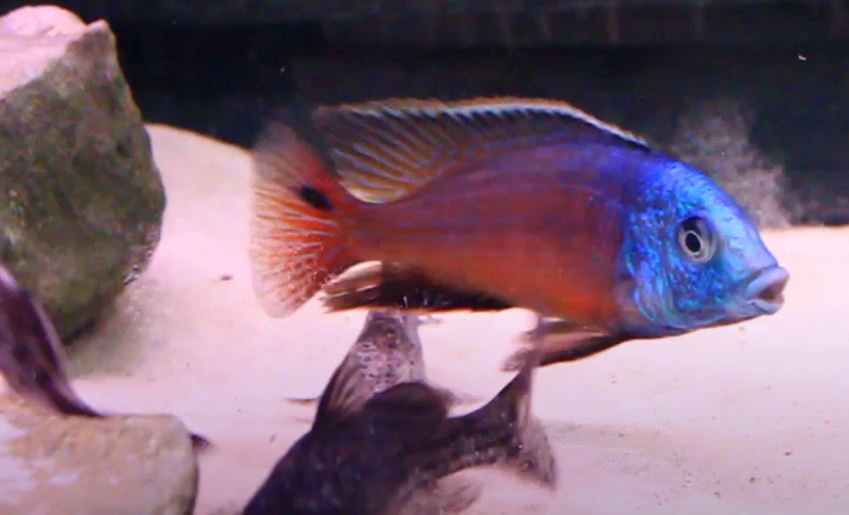
But We must admit that regardless of the captive-bred varieties the males look fabulous with their bright and vibrant colors,
Different color variations from different parts of Lake Malawi
What makes the Red Empress Cichlid special is not just its beauty but also the complex coloration based on where it lives. Because as Red Empress Cichlid is already striking in appearance, the variations in color between individuals and populations taken from different parts of Lake Malawi are even more fascinating. Some of the fish vary by as much as a third of their normal coloring, changing from shades of orange or blue to gold or bronze from their sort of general color patterns. The locals have their own names for these types of fish, giving them an identity beyond their range.
Fin Profile of Red Empress Cichlid
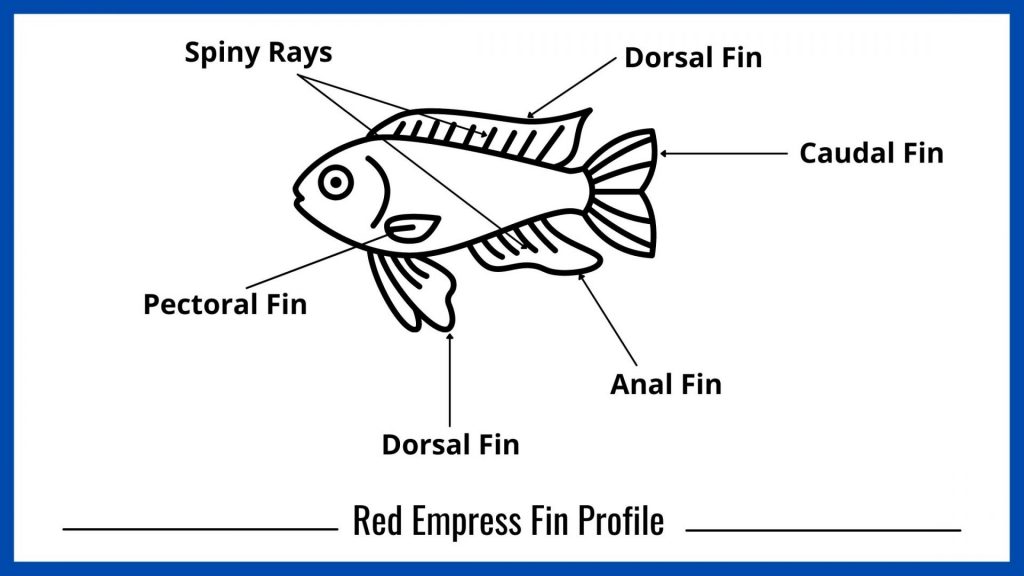
Red Empress Cichlid has several fin features that stand out, primarily to help them in their natural habitat to ward of predators and swim pretty fast. The anal, dorsal, pectoral, and caudal fins are quite long to help the fish maneuver. The fins also have spiny rays. These, in particular, help give this fish an edge in the wild by warding off predators. However, the front of each fin is softer to allow for easy navigation in the water. So it’s quite a remarkable build in terms of fin shapes and profiles.
These fish have several features that stand out, primarily to help them in their natural habitat.
Does the Red Empress Cichlid have teeth?
Of course, they do!, Just like other Cichlids fish, these have two sets of teeth. The first raw is placed normally inside the mouth of the fish but the second set is placed back in the throat!
Size
Fish are given a size range measurement, but these can be subjective. Normally the Red Empress Cichlid is on average between 4.5 and 6 inches in length. Red Empress in their natural habitat tends to reach the upper limit of their size range. However, fish that grow up in captivity generally fall on the smaller end of the spectrum. This is due to the limited space that the fish get to swim. if you can find large aquariums with plenty of space you might help the fish grow to their full size.
Love big fish? Especially the Cichlid-related fish? Then read about Kamfa Flowerhorn.
Sexual Maturity
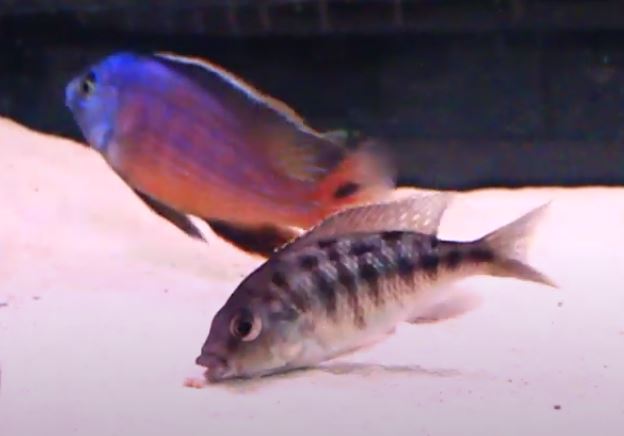
The fish reach sexual maturity at 8–9 months, and they continue growing until they reach full size. Their growth rate is fairly average for freshwater fish.
Red Empress Cichlid Care
The Red Empress is one of the most sought-after freshwater tropical fish, and there are many reasons why. They are relatively easy to care for, especially compared to other fish of its kind. It can be kept as a single specimen or in an aquarium with other fish, and it looks beautiful both during its infancy and as it ages.
Let’s look at the tank design, tank size, water parameters, and other red empress care tips, one by one.
Water Parameters
Aquarium Water Testing Kits
Thermometers
Aquarium Heaters
Aquarium Wave Makers
Malawi, where the red empress is from, has more minerals than most other areas in the world. As a result, the fish have grown accustomed to more alkaline water than other tropical fish. It is also more accustomed to salt than other species of fish. As a result, they can thrive in saltier water or at a higher pH level without any health issues.
Below are the exact water parameters you have to keep if you want a healthy and happy red empress.
The Red Empress naturally thrives in water with a pH of around 7.7 to 8.6, a hardness between 5 to 15 dGH, and a temperature between 73 to 82 degrees Fahrenheit.
Tank Size for Red Empress Cichlid
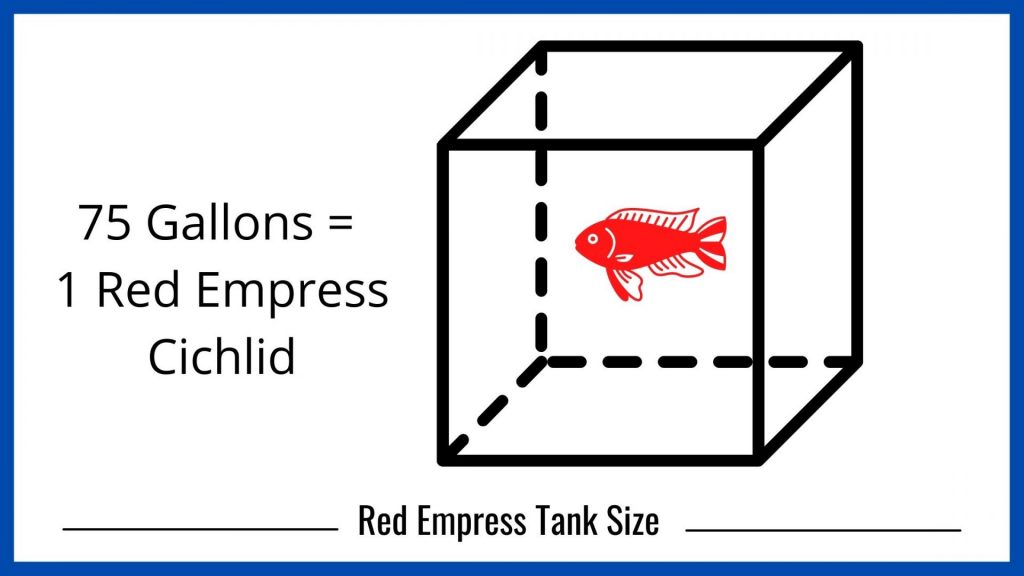
Cichlids are species that have evolved to live in large bodies of water such as lakes and rivers. As an aquarist, you can provide them with these conditions when you keep a Malawi cichlid in your very own tank. Start by stocking a minimum of 75 gallons of water in your fish tank for one red empress cichlid; according to the experts, this is the smallest tank size capable of positively supporting red empress cichlids.
The Malawi cichlid species, such as the red empress cichlid, generally swim around in the water to avoid predators and find food. Because of this, they need enough space to do what they like. A smaller aquarium won’t be enough for them, and it could actually cause stress to your fish.
So as a starter you must start with a large aquarium, which will eliminate many Cichlid issues including health and ph-related problems.
If you’re worried about keeping the Red Empress alive, don’t be. It’s very hardy. But there are a few things you should know before getting one:
While Malawi cichlids are large fish that can handle some variation in water conditions, they prefer stable water parameters. So again, large tank sizes also help keep water conditions stable — because they hold more water, they have a lower concentration of chemicals and waste.
Constant Water Movement
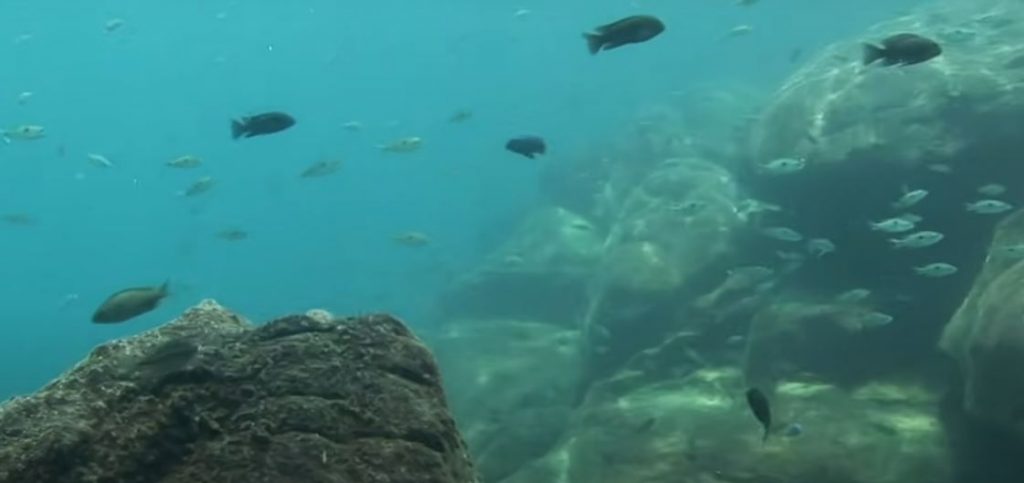
The red empress cichlid needs high flow to thrive. In the wild, they live in fast-moving water and would not be happy without lots of current in their aquarium. Strong filtration is also important as this species can produce a lot of waste.
Because this cichlid is from Lake Malawi, a very large lake in Africa. In their natural habitat, they are used to encountering a lot of movement in the water. This is because streams continuously flow into the lake, stirring up the water and providing plenty of flow.
With these fish living under such conditions, strong filtration is necessary.
Tip: If you have other tank mates who don’t like such strong currents, you can block some areas with rocks and driftwood to block the water flow through them.
Landscaping of the Tank for the Red Empress Cichlid

You must provide the natural habitat for the Red Empress. Study lake Malawi, its natural habitat and have a good understanding of the natural habitat and the lake bottom landscape they thrive. Proving the correct habitat is very important for the life span of this fish.
Sandy Bottom
The Malawi lake bottom is mostly covered with sand. So put a lot of fine sand on the bottom of their tank. Don’t put gravel as it might hurt the fish while they looking for food. This constant search for the food will keep the sand clear and will help the filtering system to clear out any residue food or waste.
Rocky Bottom
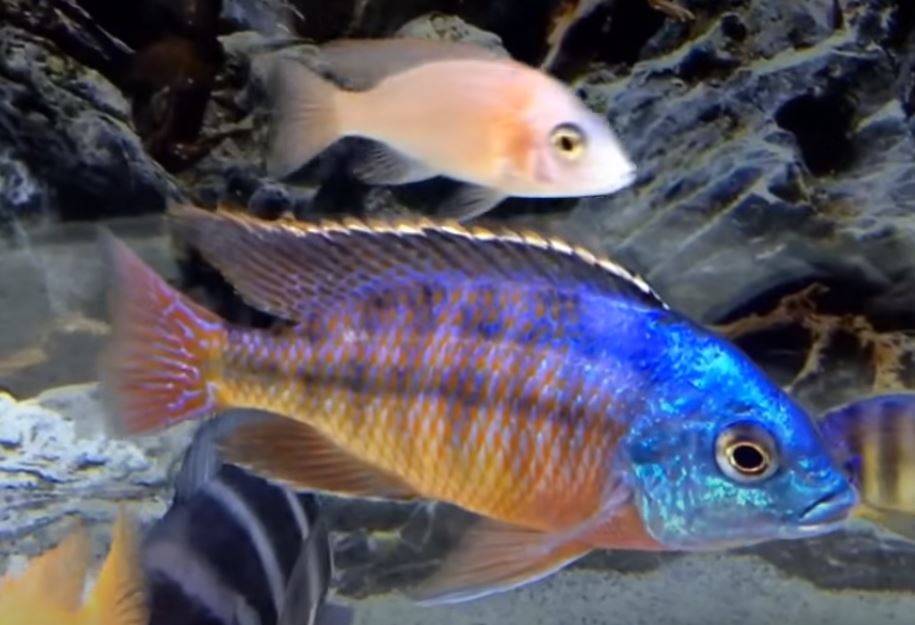
Lake Malawai also has plenty of rocks under the water, which the Cichlids swim in and out and used to hide out from predators. So it’s best if you can provide rock coverage into your Red Empress Cichlid tank as well. Also, you could entertain your aquarium with a more natural look by adding rocks. Place the rocks on one side of the tank and cover the rest with sand. Now, look at the area which meets rocks and sand. The Cichlids love it!
Moreover, did you know that the red empress cichlid In the wild mostly feeds on rock-stuck algae?
The same behavior will be carried out by the captive fish as well, so it’s another good reason to have rocks in the Cichlid tank.
Plants Vs Red Empress Cichlid
You don’t necessarily need plants in a Red Empress Cichlid tank. The rocks and sand do the trick. But if want to add some plants, you definitely can! Add some plants among the rocks, near the backdrop of the tank.
Adding plants can benefit the tank, with an additional filter of harmful nitrates and giving a more natural look.
Red Empress doesn’t eat plants but they might mess up the setup as they dig around to look for food. This is why you should place the plants among the rocks, securely.
Foods for Red Empress Cichlid
Have you ever noticed that your red empress cichlid seems to be searching for something? They might be digging in the sand because they’re looking for scraps from other aquarium inhabitants. Or maybe they’re trying to eat algae on the rocks. Either way, make sure you know what’s in the tank with them and especially, what’s on their menu.
Cichlids are omnivorous fish that consume both plants and animals. To keep your red empress healthy, you’ll need to provide both algae and meat-based food.
Algae is a staple food for this species, so be sure to include spirulina-based flakes in its diet. Also, supplement its meals with freeze-dried krill, high-protein food that you can buy at any pet store.
The diseases
Even though these fish can live in quite alkaline waters, they aren’t immune to common freshwater diseases. Below are a few diseases they are prone to.
Freshwater Ich in Red Empress Cichlid
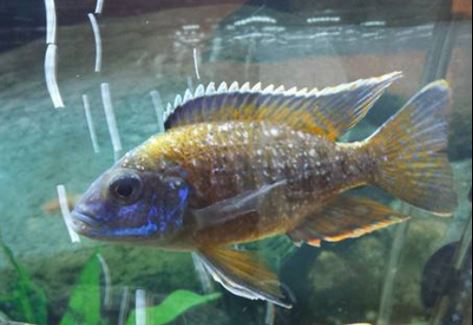
Ich, also known as White Spot Disease, is a very common problem that can affect any aquarium. Ich is a ciliated protozoan parasite that feeds on small amounts of your fish’s skin and other tissues. It can show itself in varying levels of severity: some fish develop mild symptoms, while others become severely weakened or die in just a few days if the infection is left untreated.
Treating Ich is no joke. It’s highly contagious. It’s one of the most common fish diseases and, if left untreated, will only get worse. Ich attacks your fish’s skin and is easily spread from one fish to another. However, it can be treated with a few simple steps that hold the disease at bay for many months.
As with any treatment, it’s best to quarantine all your fish to keep the Ich from spreading.
There are two ways that you can treat freshwater ich. You can either use a copper-based medicine or aquarium salt. Or you can raise the temperature of the tank to accelerate the life cycle of the ich parasite to eventually kill them faster without damaging your fish.
You must do partial water changes during the treatments to remove the swimming stage of the parasite out of the aquarium.
Bacterial, Fungi, and other Parasitic diseases
When you have a fish tank, there are many diseases that can afflict your fish. Red Empress Cichlids might have Parasites, bacterial infections, or fungi. It’s important to know how to deal with these diseases so you can keep them away from your other fish. To best avoid these diseases you have to maintain good water quality in your aquarium.
Malawi Bloat in Red Empress Cichlid
Malawi Bloat is a condition that causes a visibly swollen abdomen, loss of appetite, and other distressing signs. This condition typically occurs when cichlids in Malawi are fed an unhealthy diet.
How to avoid sick Red Empress Cichlids
The key to healthy red empress cichlids is to have optimal water parameters, enough space, and the correct habitat.
- Cycle your tank before adding your Red Empress Cichlids
Tank cycling is a necessary step for you to start raising fish. Without a healthy tank, you’re going to have a much harder time raising fish, not to mention it will be more stressful for the fish themselves. Cycling creates a supportive environment for your fish by introducing beneficial bacteria that break down harmful ammonia and nitrites.
2. Avoid overfeeding
You especially need a cycled tank for red empress Cichlid. Because they are voracious eaters and can do well eating algae, protein-rich krill, and spirulina-based flakes. This introduces lots of harmful ammonia into the aquarium. So, Avoid overfeeding your fish, or you could end up with an overweight cichlid who is prone to illness and disease. You should also make sure that you’re feeding other inhabitants of the aquarium as well the cichlid will find whatever food is left behind by other fish.
On the other hand, overfeeding can lead to Malawai bloat of your red empress cichlid which is really bad. The fish will stop eating and will have a bloated stomach and difficulties if swimming and maintaining balance.
3. Perform frequent water changes
Water changes are necessary to remove harmful ammonia and nitrite from your aquarium. 20% of water change weekly is advised.
4. Avoid fish stress
Provide a natural habitat and enough space for your red empress cichlid to avoid unnecessary stress.
If you can look after these simple steps, then there won’t be any happy fish like your Cichlid.
5. Quarantine
Quarantine your new fish before introducing them into the main cichlid tank.
Breeding Red Empress Cichlids
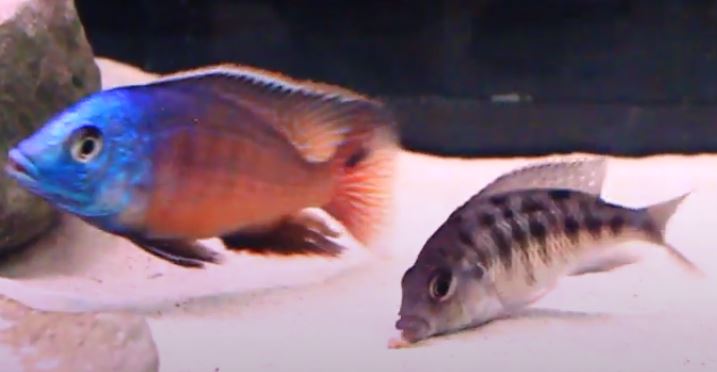
Breeding these Cichlids isn’t difficult. Just like other Cichlids, they are bred in captivity with minimum effort.
Many cichlid species are mouthbrooders. The males will choose a small rock or section of the sand and then chase females until one of them decides to follow him, at which point he will switch into a vertical position and shake with the female, releasing sperm and eggs mixing together. The red empress cichlid female will lay around 45 eggs. And she will take them into her mouth for protection, carefully incubating them until they hatch. Males will compete with one another to attract females by displaying their best colors and swimming patterns.
Red empress cichlid female is one of the best mothers in the aquarium. She incubates her eggs for around three to four weeks. Both the male and female protect each baby from predators until they’re ready to swim on their own and become a juvenile red empress cichlid. However, after the fry is swimming freely you can separate them from their parents with ease.
After all, it’s a remarkable feeling to breed and witness the reproduction of these amazing colorful fish.
Interesting Facts and Trivia
- Natural Habitat: Red Empress Cichlids are native to Lake Malawi in Africa, which is known for its vast diversity of cichlid species. Lake Malawi is one of the Great Rift Lakes and is famous for its crystal-clear waters and vibrant fish populations.
- Unique Color Variations: Red Empress Cichlids exhibit stunning color variations depending on their habitat and the individuals within their shoal. These variations can range from shades of orange and blue to gold or bronze, making each fish unique and captivating.
- Matriarchal Social Structure: Red Empress Cichlids follow a matriarchal social structure. The dominant female leads the group and maintains order within the tank. This hierarchy ensures that aggression is minimized and allows for more peaceful coexistence among the group.
- Algae Control: Red Empress Cichlids are known to feed on algae that grow on rocks. Their constant grazing helps control algae growth in the tank, providing a natural cleaning service.
- Breeding Behavior: During the breeding season, male Red Empress Cichlids display vibrant colors and perform intricate courtship rituals to attract females. The male will dig a pit in the substrate and entice the female to lay her eggs, which he then fertilizes and guards until they hatch.
Special Care Tips Summarized
- Adequate Tank Size: Red Empress Cichlids require a spacious tank to accommodate their active nature. A minimum tank size of 75 gallons is recommended. Providing ample swimming space helps reduce stress and promotes overall well-being.
- Water Parameters: These cichlids thrive in water with a pH range of 7.7 to 8.6 and a temperature between 73-82°F (24-28°C). Maintain stable water parameters and conduct regular water tests to ensure optimal conditions for their health.
- Balanced Diet: Offer a varied diet consisting of high-quality cichlid pellets, flakes, and frozen or live foods. Include both protein-rich foods and vegetable matter to meet their nutritional requirements. Supplement their diet with occasional treats like brine shrimp, bloodworms, and blanched vegetables.
- Hiding Places and Territories: Red Empress Cichlids appreciate the presence of caves, rock formations, and driftwood in the tank. These structures provide hiding spots and establish territories, reducing aggression and providing a sense of security for the fish.
- Regular Maintenance: Perform regular water changes of 20-30% every 1-2 weeks to maintain water quality and remove accumulated waste. Clean the tank and filter regularly to prevent the buildup of debris and ensure a healthy environment for the fish.
Conclusions
This comprehensive pet fish guide discussed the Red Empress Cichlid in detail. We looked into their behaviors, temperament, diet, how to care for them, susceptible diseases, and much more. Overall, the red empress cichlid is a vibrant-colored, beautiful, and hardy fish. It can be kept with other fish as well, especially with the other Malawi Cichlids species. So if you are just a beginner to the aquarium hobby, I would definitely recommend this Cichlid as they require minimum care given they are provided with enough space and other basic requirements.

Pingback: Kamfa Flowerhorn - The Ultimate Guide - Pet Fish 101
Pingback: Polar Blue Parrot Cichlid - The Ultimate Guide - Pet Fish 101
Pingback: True Parrot Cichlid (Hoplarchus Psittacus) - Pet Fish 101
Pingback: Strawberry Peacock Cichlid 101: The Complete Guide - Pet Fish 101
Pingback: Taiwan Reef Cichlid - The Comprehensive Guide - Pet Fish 101
Pingback: Gold Nugget Pleco - A Comprehensive Care Guide - Pet Fish 101